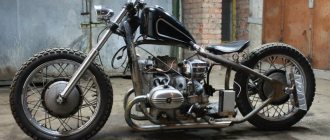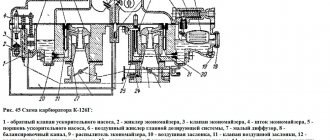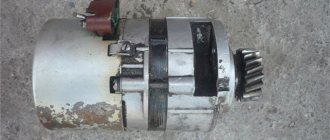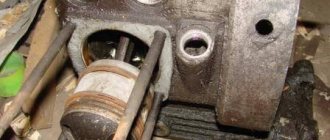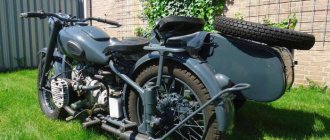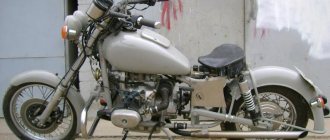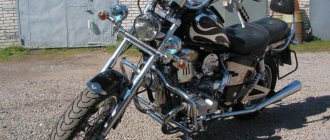Motorcycle enthusiasts are probably familiar with the Ural boxer motorcycles, which have been produced for over 60 years. In the mid-90s, the Irbit Motor Plant, where these motorcycles were produced, almost ceased to exist, but thanks to the efforts of the designers, it was able to stay afloat - the Ural Voyage was produced specifically for bikers in a very limited series.
Currently, the model is no longer produced, but Ural Voyage still managed to become one of the best domestically produced choppers. Despite this, fans of boxer technology still find used motorcycles and restore them. see photos of the Ural Voyage motorcycle on this page.
FAQ
- Where to select spare parts for it? For obvious reasons, there are no originals. If you are lucky enough to be the owner of the 650 cc version, then parts from IMZ-8.103-10 will fit the engine. And for exotic engines of 720 and 825cc there are no spare parts at all.
- I saw one like this once, with liquid cooling! Is this really a factory solution and not tuning? Yes its true. Liquid cooling was installed on 825cc engines, but not all. According to some information, there is also a 650cc with dropsy. But it is not exactly.
- I have a bike like this in my garage, but it doesn't have reverse gear. Is this normal? Fine. Some 650 cc versions were produced without reverse gear for some reason.
Estimated cost
Despite the crushing commercial failure of the model and the meager number of copies produced, Cobra gained its share of popularity.
Thus, every motorcycle, including unique devices with non-standard engines, original painting and design, was bought up by museums.
Three Cobras remained in Russia (Irbit and Samara), one went to Estonia, and the remaining dozen were taken to the UK, where such cars are highly valued by collectors.
Nowadays, it is almost impossible to purchase this exotic motorcycle due to its great rarity and uniqueness.
And if at the time of release the model was estimated at about $10,000 (due to the high cost of foreign components and small production volumes), now no one can predict the price of a restored Cobra in perfect condition.
The IMZ-8.1024 “Cobra” motorcycle is the car of an egoist who wants to emphasize his individuality and “coolness.”
Looking at such equipment, you need to understand that this is a party, image device that you don’t have to go fishing with.
Technical characteristics of Ural Voyage
The motorcycle model is IMZ-8.1233. The fuel tank capacity is 23 liters of gasoline. Dry weight of the motorcycle is 230 kg. The maximum speed is 120 km. at one o'clock. Length/Width/Height of the bike - 2530/850/1200 mm. Engine power - 36 horses. Engine type: opposed 4-stroke 2-cylinder, OHV. The motorcycle engine starting system is using an electric starter/kickstarter. The bike's electronics are 12 volts with a 500-watt generator. Gearbox - four gears + reverse gear. Gear ratio - first 3.6; second 2.28; third 1.56; fourth 1.19; rear 4.2. Wheels - R18 tires.
- Back
- Forward
JavaScript is disabled in your browser
Price guarantee
We do sell motorcycle and scooter parts at the prices shown on the website. In any case, even if the cost increases, the goods will be shipped at the prices of the placed order, except for items with a zero price (we apologize for the unloading errors, which we are currently working on correcting).
Guarantees
If the product has a manufacturer’s warranty, then during the warranty period the buyer has the right to warranty repairs or replacement of the part at the manufacturer’s service centers. The addresses of service centers are indicated in the warranty card or on the manufacturer’s website.
If the product does not have a manufacturer's warranty, then the exchange is made in accordance with Art. 25 of the Federal Law “On the Protection of Consumer Rights”: the consumer has the right to exchange a non-food product of proper quality for a similar product from the seller from whom this product was purchased, if the specified product does not suit the shape, dimensions, style, color, size or configuration, within fourteen days, not counting the day of purchase. The consumer has the right to exchange goods subject to the following conditions:
- the purchased product has not been used, its presentation, consumer properties, seals, factory labels have been preserved,
- There is a sales receipt confirming payment for the specified goods. The consumer's lack of a sales receipt does not deprive him of the opportunity to refer to witness testimony.
Spare parts, the installation of which on a motorcycle or scooter requires special knowledge, can only be returned upon confirmation of their installation at a specialized service station.
The warranty does not apply in the following cases:
- Natural wear and tear of the spare part;
- Use of a spare part for other purposes or in violation of the rules of use, operation and maintenance described in the technical documentation;
- Damage to the spare part occurred as a result of unqualified installation, damage as a result of impacts or other mechanical, thermal and chemical influences, unauthorized modification of the design, electrical, hydraulic or pneumatic systems and equipment;
- Malfunctions of spare parts of the fuel system and exhaust system due to the use of low-quality fuel (including leaded gasoline);
- The product is included in the list of non-food products of good quality that cannot be returned or exchanged for a similar product of a different size, shape, dimension, style, color or configuration (approved by Decree of the Government of the Russian Federation of January 19, 1998 No. 55) (as amended on October 20 1998, February 6, 2002) - in particular, this list includes cars and motorbikes.
Important! When returning an item, the money paid for delivery will not be returned!
Purchase returns
If the ordered goods turned out to be of poor quality or did not fit your model, or even simply turned out to be unnecessary for you, you can always return or exchange the purchased goods within the time limits provided for by the legislation of the Russian Federation. Goods damaged due to the fault of the buyer, as well as goods included in the list of non-food products of good quality that cannot be returned or exchanged, approved by Decree of the Government of the Russian Federation No. 81 of 02/06/2002, cannot be returned or replaced.
In the event of a return, you will only be responsible for the cost of sending the goods back to us.
Parts with minor defects, by agreement of the parties, can be sold at a discount.
To return funds, you must write an application at the office and present your passport or send a scan of the completed application, a scan of your passport and details for transferring funds by email.
Our recommendations: always check the availability, completeness and inspect the appearance of the goods before you sign for receipt. If you find inaccuracies, inconsistencies or problems with appearance, do not take the goods, file a return (complaint) immediately.
Important! When returning, the money paid for delivery of the goods will not be returned!
Specifications
Since there were many modifications of the motorcycle, it is difficult to judge its technical characteristics unambiguously. The 650 cc engine had 40 hp, the 720 cc engine had 45, but there is practically no information about the 825 cc engine. Otherwise, this model resembles any domestic boxer, heavy, massive and noticeably outdated at the time of release.
Engine
There were three of them, depending on the volume - 650, 720 and 825 cubic meters. see accordingly. The designers even experimented with liquid cooling! Although such examples are rare, and most of them have a 650 cc (40 hp) or 720 cc (45 hp) opposed 2-cylinder engine. Moreover, the first of them was borrowed from the old “opposites” IMZ with virtually no changes.
Transmission
IMZ engineers used a 4-speed gearbox, well known to all boxer drivers. But they did some experiments on her too! How else can you explain the fact that some Voyages have reverse gear and some do not?
Chassis and brakes
This part of the bike was least affected by the experiments, although the frame for it was developed from scratch. It was in this that they placed the engine, gearbox and everything else. Disc brakes were installed, but only on the front wheel, and at first there was only one disc, and then a second one was added to it. On the rear wheel, the drum brake was also replaced with a disc brake over time.
Electronics
The only way to understand Voyage's electronics is through practice. Apparently, during manual assembly, the factory employees were guided by some very arbitrary rules, so the wiring can vary noticeably on motorcycles from different batches. There is nothing complicated about it, but it doesn’t smell like some kind of standard.
Weight and dimensions
The Ural Voyage motorcycle not only looks heavy - it is really heavy. At least heavier than most other bikes from the Irbit plant. Its different modifications weigh from 260 to 280 kg, and its center of gravity is higher than that of its brothers in the model range, so it is not easy to move it. But its relatively compact size makes it easier to navigate city traffic jams.
Controllability
The bike has a pronounced tendency to roll over on its side, which is clearly felt when maneuvering at low speed. Sharp maneuvers are also not his thing, since it seems that the motorcycle obeys the driver’s actions extremely reluctantly. But it can boast of excellent directional stability, and even strong side winds do not bother it too much.
Fuel consumption
The brainchild of the Irbit plant, without hesitation, consumes 7-8 liters per 100 km. You can safely fill in any gasoline, especially since fuel with an octane rating below 92 is no longer possible. The gas tank capacity is 21 liters, so the bike has a decent power reserve.
Ural Voyage
Hai! Every two-wheeler lover should at least get acquainted with the latest products of the Irbit Motorcycle Plant. motorcycle will tell you everything about motorcycles, the photos of which attract true fans of the free biker life. This bike is clearly one of the best domestic choppers. It's a pity that it is no longer produced en masse, like in the good old days.
Still, you can find used versions of this steel horse in almost any country in the post-Soviet space. in the Ural motorcycle lineup.
Description of Ural Voyage
This cruiser was the result of the first efforts of IMZ designers to create motorcycles with an American style. The first copy of this motorcycle was released back in the dashing nineties of the last century. In the summer of 1996, this bike was shown to the general public at the Moscow Motor Show. Nowadays, the successor to this two-wheeler is the Ural “Wolf” line. These are more modern iron horses, equipped with a modernized 750 cc engine and high-quality disc brakes on both wheels.
You can buy a Voyage from the Irbit Motor Plant on the used transport market in the CIS. It is still not very different from the following IMZ products, which does not allow the bike to be in significant demand these days. And once upon a time this Ural gained extraordinary popularity. Our people dreamed about this motorcycle, carefully studying all its features. Reviews about Ural Voyage allowed the plant to keep sales at a fairly high level. Most of all, compatriots liked the fact that the four-stroke boxer iron horse was made in the style of the American motorcycle movement. At that time, there were no analogues to this in the post-Soviet two-wheeled mechanical engineering.
People liked the idea of creating a reliable and beautiful bike for long journeys. The technical characteristics of the two-wheeler were impressive. Reliable disc brakes on a Russian heavy bike seemed like a fantastic innovation at that time. The same can be said about the electric starter. In conditions of urban motorcycle use, this innovation turned out to be very convenient. The improved optics of the military IMZ allowed our fellow citizens to move around in the dark with greater comfort. Even the motorcycle saddle has been updated. It turned out to be a much softer and more comfortable design for long trips.
The price of Ural Voyage turned out to be acceptable for many admirers of the biker life. Fans of two-wheelers became primarily those motorcyclists who needed a significant supply of motor power on the road. This is the only way to confidently perform serious maneuvers on the road. The bike, with its enormous mass, can accelerate quickly, which is good news. However, this iron horse also has its drawbacks. Negative reviews of the Voyage IMZ primarily concern the motorcycle wiring. It was installed poorly at the factory. This slightly spoils the aesthetics of the motorcycle. The reliability of other structural elements of the four-stroke steel horse is also not encouraging. When the bike is overloaded, its individual components may fall off. The conclusion is simple: before starting a road trip, you need to inspect the two-wheeler for dismantling/loosening/springing.
Technical characteristics of Ural-4320:
| Years of production | 1977-present |
| Assembly | OJSC "Automobile plant "Ural"" |
| Class | off-road truck |
| Design | |
| Body type(s) | onboard |
| Layout | front-engine, all-wheel drive |
| Wheel formula | 6x6 |
| Engines | KamAZ-740, YaMZ-236NE2 or YaMZ-238 |
| Transmission | manual 5-speed |
| The transfer case is two-stage. | |
| Gear ratios | 1st gear - 2.05; 2nd gear - 1.30 (since 2002, the gear ratio of 2nd gear is 1.21). |
| The main gear of the drive axles is double, the gear ratio is 7.32. | |
| Mass-dimensional | |
| Length | 7366 mm |
| Width | 2500 mm |
| Height | 2715 (with awning 3005) mm |
| Clearance | 400 mm |
| Wheelbase | 3525+1400 mm |
| Rear track | 2000 mm |
| Front track | 2000 mm |
| Dynamic | |
| Max. speed | 85 km/h |
| On the market | |
| Predecessor | Ural-375D |
| Similar models | ZIL-131, KrAZ-255B |
| Other | |
| Fuel consumption | 27 l/100 km at 40 km/h |
| Volume of the tank | 300 + 60 l |
At one time, the brainchild of the Irbit plant was in great demand. An excellent assistant in agriculture and serving as an excellent alternative to a car, the Ural had the ability to move on any road surface. The plant has currently stopped producing motorcycles. This happened due to a banal economic recession. In recent decades, the assembly of the Ural motorcycle engine has become an analogue of the German BMW-R71, as well as the stubborn competitor of the Dnepr.
The engine of the Ural motorcycle, the technical characteristics of which can easily compete with the new generation motorcycles, is subject to severe wear and tear. Therefore, owners often have to go through all the parts themselves and replace them.
The Soviet bike is considered a heavy motorcycle intended for rural work and transportation of goods. At the same time, it has relatively small but sufficient indicators. The Ural motorcycle engine on the Solo model produces 40 horsepower
. And with boost you can achieve 55 hp. The maximum speed of the bike is 110 km/h. For such power, this is a rather modest figure, because the speed is greatly influenced by the mass of the motorcycle. However, the acceleration is quick and the bike's dynamics are very pleasant for the rider.
The engine capacity of the Ural motorcycle is 745 cm3, which makes it one of the largest in Russian production. In this case, the torque reaches about 4000 rpm
. Such engines are typical for engines with gearboxes, rather than for boxer engines.
Technical specifications
- The volume of the gas tank is 23 liters.
- Weight – 230 kg.
- Maximum speed – 120 km/h.
- Engine power – 36 hp.
- Engine type – 4-stroke opposed air-cooled.
- The starting system is a classic version with kickstarter, as well as electric start.
- Gearbox – four-speed + reverse gear.
- Electrical equipment – 12-volt generator with a power of 500 W.
Post Views: 7,524
Advantages and disadvantages
It is impossible to judge this bike unambiguously, because it was continuously modified and modernized throughout its production. The differences between copies released at different times are sometimes no less than the similarities, although there is still something in common.
Advantages
- The 825 cc liquid-cooled engine has good acceleration dynamics.
- Some spare parts are suitable either from IMZ-8.103-10, or from “Wolf” and “Solo Classic”.
- The Ural Voyage motorcycle is now so rare that it can be called a collector's item. And this is a good reason to buy such a beast and, if possible, restore it to the original.
Flaws
- Some parts are impossible to find. At all.
- Build quality ranges from good to terrible, but the second option is more common.
- An ill-conceived design has many weak points, which leads to frequent breakdowns.
Description of the motorcycle
The Ural Voyage was born thanks to the efforts of the design department of the Irbit Motor Plant - this model absorbed many of the features of American motorcycles - the first copy rolled off the assembly line back in the mid-90s, and was first presented to the public at the Moscow Motor Show.
Subsequently, the model was developed - the more modern Ural “Wolf” was equipped with a modernized 750 cc engine, as well as an imported disc-type braking system. Unlike classic heavy motorcycles produced by IMZ, the Ural Voyage did not have a side trailer - a sidecar, because it was intended exclusively for bikers.
meet the Ural Voyage motorcycle throughout the CIS, and it is not very different from the classic motorcycles of the USSR - in the mid-90s, this model was wildly popular due to its similarity with classic American bikes.
Modern models
It is noteworthy that it was during difficult times for the plant that such popular motorcycles as the Ural “Voyage” and the flagship model Ural “Wolf” appeared.
The heavy road motorcycle Ural "Wolf", which rolled off the assembly line in 1999, became a favorite model of Russian bikers. The motorcycle is equipped with a 745 cc engine. cm 45 hp and accelerates to 152 km/h. Thanks to its unusual design and driving characteristics, the Ural “Wolf” chopper rightfully tops the rating of the plant’s most successful models.
As for the Ural Voyage motorcycle, which appeared a little earlier (in 1996), this model had more modest characteristics: a 650 cc engine. cm with a power of 36 hp, allowing you to reach speeds of up to 120 km/h.
Other models also rolled off the assembly line: the army version of the Ural Gear-Up motorcycle with camouflage colors, the Ural Solo-DPS patrol motorcycle with a windshield, siren and signal lights, and the Ural Hercules heavy motorcycle for transporting cargo.
Ural "Tourist" is one of the best examples of touring motorcycles for long trips, including off-road, accelerating up to 120 km/h. The Tourist 2WD model became an all-wheel drive version of this motorcycle with additional drive to the sidecar wheel.
The Ural “Retro” model is made in the style of the 40-50s, although today this motorcycle with a black leather seat and velor upholstery of the sidecar looks more than modern and stylish.
In 2007, the Ural “Desert” motorcycle was released with a lever front fork and a microprocessor ignition system, designed for riding on sand, and the Ural “Vyuga” model with a powered sidecar for use in winter.
In 2015, a limited edition of motorcycles with a Ural sidecar was released, dedicated to the new part of the Star Wars film. The model was called "Dark Force" and was sold only in the USA. The Ural Dark Force, a rear-wheel drive two-seater, produces 41 horsepower with a four-speed manual transmission. It has a two-cylinder opposed air-cooled engine with a volume of 749 cubic centimeters with an electronic fuel injection system. In addition to the LED headlight, according to the manufacturer, a real lightsaber was included with the motorcycle.
Article review of the Ural Voyage motorcycle
The Ural Voyage is a controversial model, or rather an attempt by Soviet engineers to make something similar to the American chopper style. The idea, which arose in 1996, was a fiasco, which is not surprising, because it has a weak engine.
If you purchase a Ural Voyage, try to find it without tuning, in the original. There are Brembo brakes here, a late modification with a disc rear brake. There is an electronic ignition and a very funny horn next to it. The engine is carburetor, and its engines vary from 650 to 750 cc in different years. Produces 44 hp, which allows you to drive confidently in any conditions. The front fork is classic, telescopic, with an ambiguous unstable coating. At the rear there is a classic fork with two shock absorbers “a la Harley style”. And of course, the main factor for lovers of chopper equipment is that everything here is made of iron. There is no plastic, everything is solid, powerful and thorough. According to the control panel - on the left there are “classic” turn signals, like on the “Japanese” ones, switches for low and high beam; on the right there is a switch for side lights and low beam, as well as a button for blocking the engine and brakes.
By the way, it will be interesting to purchase the latest Voyage models, because it was in them that Ural tried to introduce into production what ordinary users had tried to tune before. The downside is a bad electric starter, which is more likely to leave you inoperative. The gearbox of this bike is worth praising because the kick starter is very light and turns the crank without any problem. There is also a non-standard exhaust for Urals, a classic driveshaft and a huge car battery. The air intakes were made interestingly for those years - they were a chrome strip with gills. It’s worth saying a few words about starting the engine. As with any Soviet bikes, this is a whole art. It all starts with opening the gas tap, then lowering the float and waiting for the gasoline to drip. The sound of the motorcycle is “classic Ural”, howling. The gearbox is four-speed. It's as slurred as the clutch. The only thing that works well here is the front brake. Therefore, this motorcycle is very dangerous to ride, it is a real challenge to your fears, but perhaps that is why it is so fun to ride. On the road you will have to constantly concentrate on the controls. The front suspension is unfinished. Everything makes noise, rattles, groans, drips, and for this model this is the norm. In a word, the pilot on such a bike truly believes in God and prays every time at 80 km/h to get to his destination.
Getting started on this motorcycle is also a different story. In general, Voyage is contraindicated for beginners. But, despite this, many retro lovers are now hunting for such bikes. And that’s all, because this is a unique development of the Urals and very few are left alive now, which makes them valuable in the eyes of collectors. Therefore, the price of this model varies from 70 to 200 thousand rubles. The motorcycle is not for rides, but for connoisseurs and gourmets who can go out and show off on it several times a year.
A collector's dream
Unfortunately, the future of the Cobra model turned out to be absolutely unpromising.
IMZ proposed producing a chopper with a “dry” frame, but this idea was rejected, explaining that it was inappropriate to manufacture motorcycles without shock absorbers.
When the motorcycle was appreciated by the public, the plant had already switched to producing the IMZ-8.1238 model, called “Wolf” and which is an evolved version of the “Cobra”.
The Irbit Motorcycle Plant produced only 16 copies of this motorcycle, the last of which were equipped with various types of power units for a comprehensive study of consumer demand.
History of creation: the legend about the German BMW
There is a legend about our heavy motorcycle, according to which it was allegedly secretly copied from a German BMW motorcycle produced in 1938, purchasing for this purpose either in Germany or in Sweden five production vehicles of the R-71 model. Our military, they say, were impressed by the Nazis’ victorious march across Europe, in which mechanized units, including motorcycles with sidecars, played a huge role in the success.
“We didn’t steal anything, that’s not true!” - objected the director of the Irbit State Motorcycle Museum Alexander Bulanov. — In 1940, when we started production, the Soviet Union was on good terms with Germany. The Germans themselves gave us both the license and the drawings.
By the way, when deciding to choose a prototype for a Soviet army motorcycle, our specialists then considered other options: American cars, English ones, the same German ones (for example, a more technologically advanced BMW model under the symbol R-12, which later became the main one in parts of the Wehrmacht). But, as time has shown, it was the R-71 that turned out to be the most successful, including because it was well suited for further modernization.
At first, the production of the Soviet army motorcycle with a sidecar was launched in Moscow, but in the fall of 1941 (after the rapid advance of German troops towards the capital), it was decided to move production to the Urals. The first train with equipment arrived in Irbit on November 19, 1941. The machines were placed on the premises of a former... brewery. And just three months later - on February 25, 1942 - the first batch of vehicles was produced.
The first Irbit motorcycles differed little from their German prototype: they had, in fact, the same opposed two-cylinder engine with a volume of 746 cubic centimeters, developing a power of 22 horsepower. Thanks to the lower arrangement of the valves in the cylinders, it pulled great at the “lower levels” and overcame any off-road conditions. The few changes that appeared were dictated by the conditions of production and operation of the cars: on the M-72, the wheel spokes became thicker, the gas tank held not 14 liters of gasoline, like a German motorcycle, but 22.
Decrease in production
— When I was in Japan, I visited their motorcycle museum. So, it’s very clear how they have dramatically rushed forward since the mid-70s. And at that time we just slowed down. We were severely limited in new materials. If capitalists were already making titanium frames, then we couldn’t even dream about it, says Nikolai Volozhanin (and the world’s largest titanium production enterprise, VSMPO-Avisma, is located in the Sverdlovsk region - in Verkhnyaya Salda).
The Sverdlovsk people slowed down not because they lacked technical ideas. They were - and what kind of ones! But at that time there were no motorcycles with sidecars for free sale; the demand for them greatly outstripped the supply. Probably, someone at the top thought that in this situation there was no point in spending money and resources on modernization. A typical example is the fate of the best motorcycle from the Irbit plant, M-73. For 1980, when it was created, it was an advanced development.
“I tested this motorcycle myself,” says Alexander Bulanov. — Amazing car: powerful 750 cc engine, electric start, hydraulic brakes. More than a dozen original inventions were obtained by the plant’s specialists when creating this model. We tested it and got the go-ahead for mass production. But to release a new product for the first five years, 4.8 million rubles were required. The plant never received them, although it generated a net profit of more than 20 million rubles annually. M-73 never went into production...
Irbitsk residents issued the millionth motorcycle in 1975, the two millionth in 1985, and the three millionth in 1993. The largest number of motorcycles - 131 thousand - was produced in 1992. Then there was a decline in production: 1993 - 121 thousand, 1994 - 68,700, 1995 - only 11,700. Why did this happen?
“The main reason is that there is no consumer,” says Nikolai Volozhanin. — When prices were lowered in the early 90s and wages fell, rural workers and residents of small towns no longer had time to buy a new motorcycle; most did not have enough money to live on.
Interesting Facts
| This section is an unordered list of various facts about the subject of the article. Please bring the information into an encyclopedic form and distribute it to the appropriate sections of the article. As decided by the Wikipedia Arbitration Committee, lists should preferably be based on secondary, aggregated authoritative sources that provide criteria for inclusion of items in the list. |
| External images |
| Motorcycles "Ural" in Iraq |
- In 2002, Saddam Hussein's Republican Guard ordered 2,000 Ural motorcycles with sidecars to support their defensive strategy based on high mobility tactics. Officially, the motorcycles were intended for the Iraqi Ministry of Health and Ministry of Agriculture. About 1,500 motorcycles were delivered before the start of the Iraq War as part of the Oil-for-Food program, which aroused great interest among the military and the public. However, after the overthrow of Saddam Hussein's regime, the State Transport Company of Iraq, which entered into an agreement on the supply of motorcycles, was forced to look for other buyers. According to Iraqis, motorcycles with sidecars are well suited for moving around the city and off-road. Due to the ongoing violence and the danger of coming under fire at any moment on the street, the Iraqis weld additional protection on the vulnerable spots and sidecar of the Urals and install a machine gun on the motorcycle. Representatives of the American command in Iraq have repeatedly expressed concern about the appearance of such motorcycles with machine guns among Iraqi rebels.
- The new generation Russian Ural motorcycle took part in the filming of the film “Ghost Rider 2”.
- In December 2013, at the last stage of the Olympic torch relay of the 2014 Winter Olympic Games in the city of Kamensk-Uralsky, 11-time Russian motocross champion Evgeny Shcherbinin carried the torch on a Ural motorcycle, and on February 8, 2014, 20 Ural motorcycles took part in opening ceremony of the Olympic Games in Sochi.
- In November 2022, the Ural Brand presented a prototype of the Ural electric motorcycle with a sidecar. The prototype was created on the basis of the existing ST chassis with single-wheel drive. The motor, battery, controller and other components are from the famous American manufacturer of electric bikes Zero Motorcycles. The manufacturer's management later revealed some plans for the electrical project.
People's motorcycle: a success story
In 1955, the military order was transferred to the Kyiv Motorcycle Plant (which produced cars under the Dnepr brand). The Urals had no choice but to switch to civilian consumers. And it is in this market segment that Irbit motorcycles have achieved incredible success. The first civilian model was the M-72M.
“It was a real workhorse.” In villages and small towns, this motorcycle literally performed the function of a horse: it was easy to bring a haystack or bags of potatoes for fishing. Take it anywhere! — says Alexander Bulanov.
At first, Irbit motorcycles did not have their own brand - only letter designations. The first car with a name was the M-61 model - it was called “Irbit”.
And only in 1961, when the M-62 model was released, Irbit motorcycles received the name “Ural”. At the same time, large-scale production of motorcycles began.
— Our most popular model over the years was probably the M-63 motorcycle. It was produced for 8 years: from 1963 to 1971,” says former plant director Nikolai Volozhanin.
Nikolai Volozhanin
Nikolai Ivanovich will turn 80 this year. He is a living legend of the Irbit Motor Plant; he was its director twice. The first time was from 1979 to 1983, and the second time was at the end of the enterprise’s glory, from 1987 to 1995. He himself had three Urals, in which he participated in long-distance runs.
The most famous of them took place in 1968. Then a team of Irbitsk residents went to an international gathering of, as they would say today, bikers, which took place in Italy. According to the recollections of Nikolai Volozhanin, nine motorcycle plant workers left Irbit on eight locally produced motorcycles. It took 50 days to get to Italian Perugia, where the rally took place, and back; we drove 11 thousand kilometers - and with virtually no breakdowns. Probably, then “abroad” saw the Ural motorcycle for the first time. As Nikolai Ivanovich said, even in the company of eminent brothers, “Ural” looked good. The technical lag of the Irbit motorcycle began later...
Motorcycle Features
First of all , the Ural Voyage was produced for lovers of long-distance travel - the technical parameters of the motorcycle made it possible to ride throughout the country, while the presence of serious breakdowns was practically excluded. The ability to start a motorcycle with a button and reliable disc brakes - in those days, for the average motorcyclist, such features were in the realm of fantasy.
The electric starter was very useful when operating the motorcycle in city conditions; in addition, improved headlight optics allowed motorcyclists to travel at night with greater comfort. The saddle of the Ural Voyage motorcycle ensured the comfort of the driver and passenger - even after long trips, the “fifth point” did not make itself felt.
The price of the Ural Voyage motorcycle turned out to be affordable for most motorcyclists: they purchased this model due to its significant power reserves, as well as the possibility of rapid acceleration. Despite the brutal appearance and good technical parameters, the Ural Voyage had one serious drawback - the wiring of the motorcycle at the factory left much to be desired.
In addition, when the motorcycle was overloaded, some structural elements could simply fall off while driving, so regular tightening of the main bolts was required before leaving.

